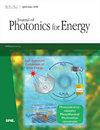Device modeling of Cs2PtI6-based perovskite solar cell with diverse transport materials and contact metal electrodes: a comprehensive simulation study using solar cell capacitance simulator
IF 2.1
4区 工程技术
Q4 MATERIALS SCIENCE, MULTIDISCIPLINARY
引用次数: 1
Abstract
Abstract. Recently, all-inorganic double perovskite, lead-free absorber-based perovskite solar cells (PSCs) have been an active area of research. Due to its narrow bandgap and wide and high absorption, Cs2PtI6-based PSCs have generated wide interest. In this work, a comprehensive study of a Cs2PtI6-based PSC using solar cell capacitance simulator (SCAPS) one-dimensional is conducted. The simulation result is validated by comparing it with experimentally reported Cs2PtI6-based PSCs. To design a highly efficient, commercially feasible PSC, the variation in the performance of the PSC with six different electron transport layers (ETLs), ten-hole transport layers (HTLs), and nine metal contacts is investigated by simulation. Among the tried configurations, FTO / ZnO / Cs2PtI6 / MoO3 / Cu yielded the highest power conversion efficiency (PCE). The effect of varying the parameters of thickness, defect density, and doping concentration of the absorber layer; thickness, and doping concentration of the transport layers; and defect density of the interface layers on the performance of the device is investigated. The optimized device configuration yields an open-circuit voltage (Voc) of 1.3856 V, short-circuit current density (Jsc) of 16.107 mA / cm2, fill factor (FF) of 75.54%, and PCE of 16.85%. When the simulation is done with different back metal contacts, carbon yielded encouraging results with a Voc of 1.4105 V, Jsc of 16.112 mA / cm2, FF of 90.01%, and PCE of 20.45%.具有不同传输材料和接触金属电极的Cs2PtI6基钙钛矿太阳能电池的器件建模:使用太阳能电池电容模拟器的综合模拟研究
摘要近年来,全无机双钙钛矿、无铅吸收剂基钙钛矿太阳能电池(PSC)已成为一个活跃的研究领域。Cs2PtI6基PSCs由于其窄的带隙和宽而高的吸收,引起了人们的广泛兴趣。在这项工作中,使用太阳能电池电容模拟器(SCAPS)一维对基于Cs2PtI6的PSC进行了全面的研究。通过与实验报道的基于Cs2PtI6的PSC进行比较,验证了仿真结果。为了设计高效、商业可行的PSC,通过模拟研究了具有六个不同电子传输层(ETL)、十个空穴传输层(HTL)和九个金属接触的PSC的性能变化。在尝试的配置中,FTO / ZnO / Cs2PtI6 / 三氧化钼 / Cu产生了最高的功率转换效率(PCE)。改变吸收层的厚度、缺陷密度和掺杂浓度等参数的影响;传输层的厚度和掺杂浓度;研究了界面层的缺陷密度对器件性能的影响。优化的器件配置产生1.3856 V的开路电压(Voc)和16.107的短路电流密度(Jsc) 毫安 / cm2,填充因子(FF)为75.54%,PCE为16.85%。当用不同的背金属触点进行模拟时,碳产生了令人鼓舞的结果,Voc为1.4105V,Jsc为16.112 毫安 / cm2,FF为90.01%,PCE为20.45%。
本文章由计算机程序翻译,如有差异,请以英文原文为准。
求助全文
约1分钟内获得全文
求助全文
来源期刊

Journal of Photonics for Energy
MATERIALS SCIENCE, MULTIDISCIPLINARY-OPTICS
CiteScore
3.20
自引率
5.90%
发文量
28
审稿时长
>12 weeks
期刊介绍:
The Journal of Photonics for Energy publishes peer-reviewed papers covering fundamental and applied research areas focused on the applications of photonics for renewable energy harvesting, conversion, storage, distribution, monitoring, consumption, and efficient usage.
 求助内容:
求助内容: 应助结果提醒方式:
应助结果提醒方式:


